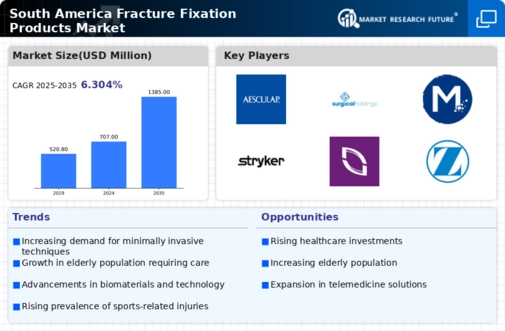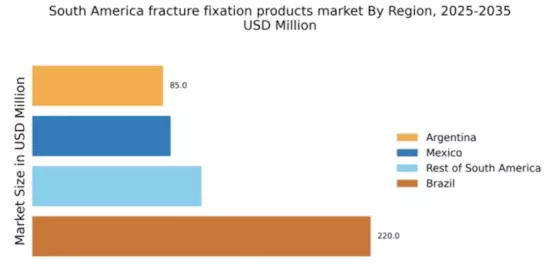Growing Elderly Population
The increasing elderly population in South America is a crucial driver for the fracture fixation-products market. As individuals age, they become more susceptible to fractures due to conditions such as osteoporosis. This demographic shift is expected to lead to a higher demand for fracture fixation devices. According to recent estimates, the elderly population in South America is projected to reach 20% by 2030. This trend indicates a significant market opportunity for manufacturers of fracture fixation-products, as healthcare providers will need to address the rising incidence of fractures among older adults. Consequently, the fracture fixation-products market is likely to experience substantial growth as healthcare systems adapt to meet the needs of this aging population.
Rising Incidence of Sports Injuries
The growing popularity of sports and physical activities in South America is contributing to an increase in sports-related injuries, thereby driving the fracture fixation-products market. As more individuals engage in recreational and competitive sports, the likelihood of fractures and other musculoskeletal injuries rises. Recent data suggests that sports injuries account for a significant portion of emergency room visits, with fractures being among the most common injuries treated. This trend is prompting healthcare providers to invest in advanced fracture fixation solutions to ensure effective treatment. Consequently, the market is expected to expand as manufacturers respond to the increasing demand for specialized fixation devices tailored for sports injuries.
Growing Awareness of Orthopedic Health
There is a rising awareness of orthopedic health issues among the South American population, which is significantly impacting the fracture fixation-products market. Educational campaigns and community health programs are informing individuals about the importance of bone health and the prevention of fractures. This heightened awareness is leading to increased consultations with healthcare professionals and a greater demand for orthopedic treatments. As patients become more proactive about their health, the need for effective fracture fixation solutions is likely to rise. Market analysts predict that this trend could result in a 10% increase in the demand for fracture fixation-products over the next five years, as more individuals seek timely interventions for their orthopedic concerns.
Technological Advancements in Medical Devices
Technological innovations in medical devices are transforming the fracture fixation-products market in South America. The introduction of advanced materials, such as bioresorbable implants and minimally invasive surgical techniques, enhances patient outcomes and reduces recovery times. For instance, the use of 3D printing technology in creating customized fixation devices is gaining traction. This not only improves the fit and functionality of the devices but also reduces manufacturing costs. As a result, the market is witnessing a shift towards more sophisticated and effective solutions. The adoption of these technologies is expected to increase the overall market value, with projections indicating a growth rate of approximately 8% annually over the next five years.
Government Initiatives to Improve Healthcare Access
Government initiatives aimed at enhancing healthcare access in South America are positively influencing the fracture fixation-products market. Various countries in the region are implementing policies to improve healthcare infrastructure and increase funding for medical services. These initiatives often include the expansion of public health programs that focus on trauma care and orthopedic services. As a result, hospitals and clinics are more likely to invest in advanced fracture fixation-products to provide better care for patients. This increased accessibility to healthcare services is expected to drive market growth, with estimates suggesting a potential increase in market size by 15% over the next few years.


















Leave a Comment